Syria: What can Russia's military do?
- Published
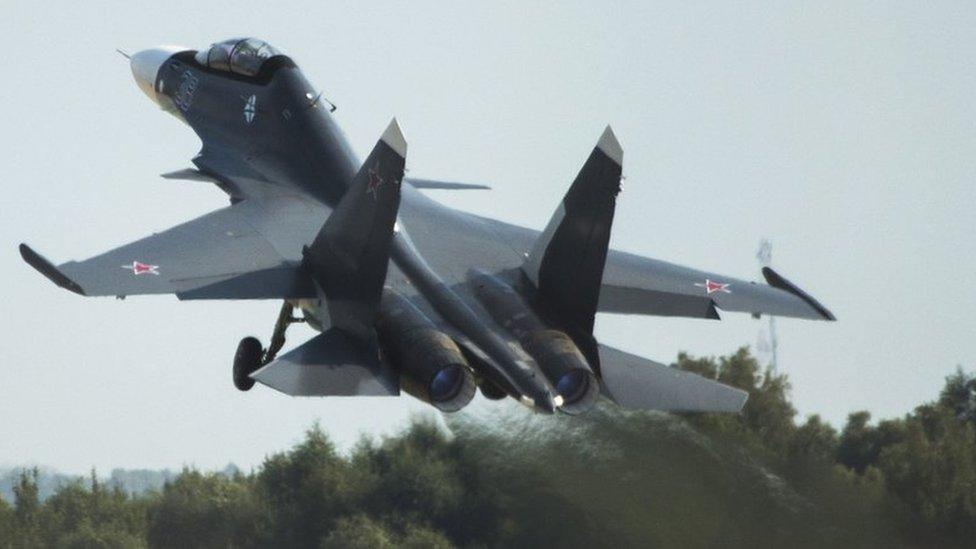
Russia has four SU-30 fighter jets among its 34 fixed wing aircraft in Latakia
This is the first Russian military operation beyond the boundaries of the former Soviet Union since the end of the Cold War.
But the US and its coalition partners have already conducted more than 7,000 air strikes in Syria and Iraq against the so-called Islamic State (IS). And even on the most optimistic assessment their impact has been limited.
IS is contained but in no sense defeated. So why should Russia be able to do any better?
Russia of course is restricting its strikes to Syria. Its initial combat missions suggest that its fundamental aim is to relieve pressure upon President Bashar al-Assad's embattled forces and that its list of targets will go well beyond those exclusively linked to IS.
But what military capabilities do the Russians actually have? What weapons can they use? How does the Russian air force compare to its Western equivalents? And what ultimately can it achieve?
What hardware does Russia have?
A mix of old and new
The air expeditionary force that has been despatched to Syria represents a microcosm of the Russian air force as a whole.
As Michael Kofman, a US-based analyst with the CNA Corporation, external notes, Russia has some 34 fixed-wing aircraft based at Latakia - a mixture of types, comprising: 12 Su-25s; 12 Su-24M2s; four Su-30SMs; and six Su-34s.
"This," he told me, "represents both the older generation of venerable Soviet strike aircraft and the new, most modern, multi-role strike aircraft Russia has to offer.
"The Su-25," he explains, "is a close ground support and strike platform, used throughout Russia's wars, including Chechnya and the Russia-Georgia war. This aircraft is quite capable of close support, but rather vulnerable and easy to lose, particularly to MANPADS (man-portable or shoulder-fired surface to air missiles) which have proliferated across the Syrian battle space.
"The Su-24M2 is the classic tactical bomber, modernised from Soviet days and capable of a variety of strike missions but a rather worn and older aircraft."

Russian Su-25 SM ground attack aircraft have been used throughout Russia's recent wars
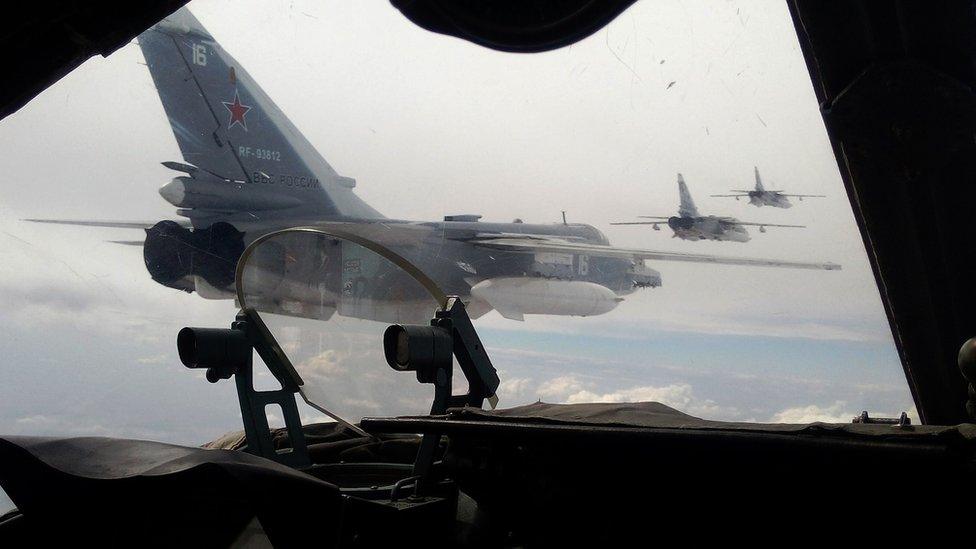
The older but versatile Su-24 fighter bomber
The more interesting elements of the deployment, says Mr Kofman, are the Su-30SMs and the Su-34s. "The Su-30SM is a heavy multi-role fighter, capable of both air-to-air combat and a variety of precision strike missions at higher altitudes."
The recent arrival of Su-34 ("Fullbacks" according to their Nato code-name) completes the picture. "These are much more advanced strike aircraft, essentially replacements for the Su-24M2, and are able to conduct the full spectrum of bombing and defending themselves in air-to-air. These have never been to war and Russia may not just be using them, but indeed testing them."
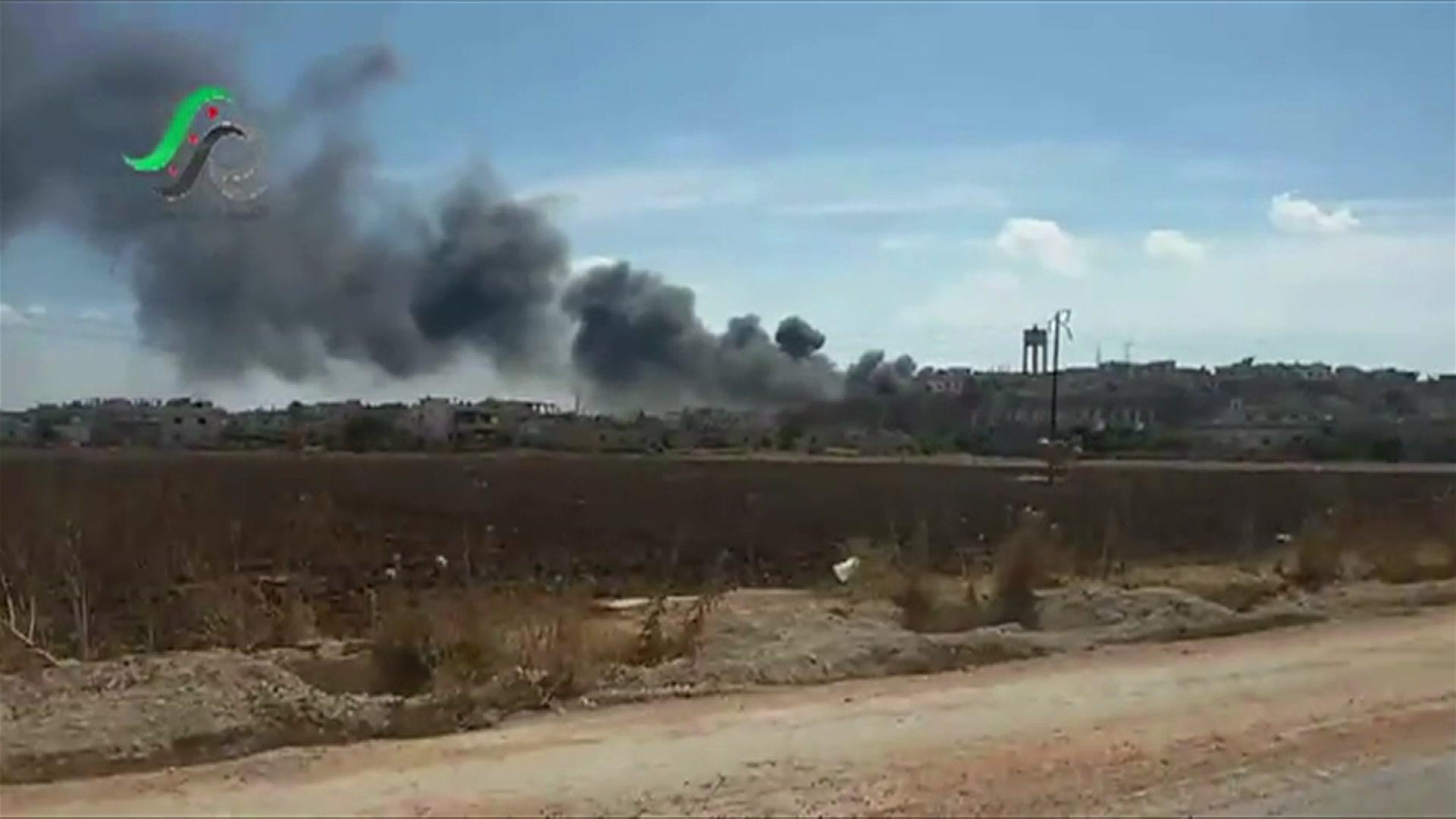
Activists posted footage showing the aftermath of Russia's strikes in Homs province last Wednesday
Weapons capacity
So much for the Russian aircraft then, but what about the munitions they can deliver?
The first few days of Russia's air campaign in Syria have enabled us to get a better idea of the munitions being used by the Russian air force.
Video material released by the Russian ministry of defence, external along with stills and other video material show a variety of weapons being used, the overwhelming bulk of which appear to be dumb - that is to say unguided - bombs rather than the precision-guided munitions that dominate Western air campaigns.
OFAB 250-270 fragmentation bombs have been seen being loaded on Russian aircraft at Latakia as well as OFAB 250-500s and OFAB 100-120s.
Some GPS-guided KAB-500S bombs have also been seen. Evidence has emerged of the use of cluster munitions (the SPBE-D) another Russian system, though this could have equally been dropped by a Syrian jet.
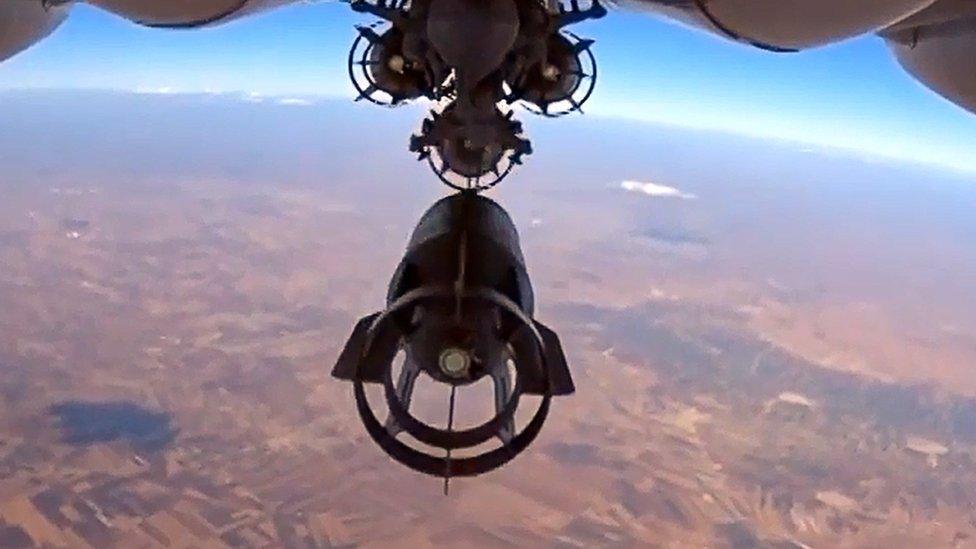
Footage made available by the Russian Defence Ministry, purporting to show a Su-24M bomber dropping bombs during an airstrike in Syria
According to Douglas Barrie, Senior Fellow for Military Aerospace at the International Institute for Strategic Studies, external in London: "The Russian air force today lacks the breadth of precision weapons and targeting systems fielded by the most capable of its Western counterparts. This is not a new problem for the air force, since this issue was exposed during the Georgian war in 2008.
"Since then," says Mr Barrie, "Russia's air force and industry have re-invigorated efforts to finish development and acquire weapons and target designation systems akin to those fielded by the likes of the US and leading European countries. The problem originated with the collapse of the Soviet Union and almost decades of very little investment in developing advanced weapons systems."
There are some other notable differences in technology.
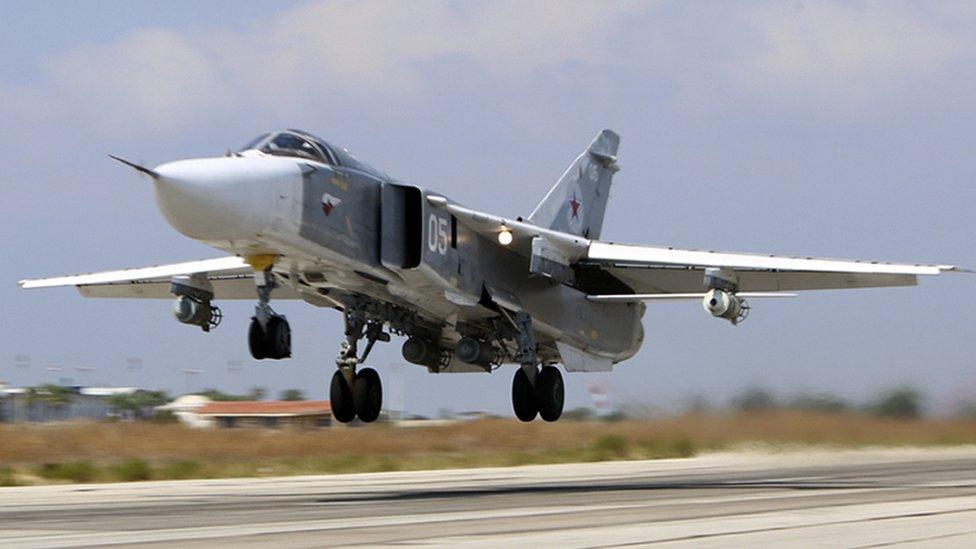
Russian Su-24M jet fighter armed with laser guided bombs takes off from a runaway at Hmeimim airbase in Syria
While the Russians do have semi-active laser and electro-optically guided bombs and missiles, and laser target marker systems on the Su-25 Frogfoot and Su-24 Fencer, they do not deploy the kind of targeting pods carried by Western aircraft which help both to acquire a target and to guide weapons to it.
Though some drones have been deployed to Syria, Mr Barrie notes that the Russians "also lack the level of unmanned aerial systems for intelligence, surveillance and reconnaissance that the US and it allies used widely in Afghanistan. Nor has it had the same level of experience of air-ground integration in recent years."
Russian cockpit footage purports to show air strikes hitting Syria
Attacking from the sea
As well as air strikes, Russia has launched rocket attacks on IS targets in Syria from warships in the Caspian Sea - about 1,500km (930 miles) away.
Russia's Defence Minister Sergei Shoigu said four warships fired 26 sea-based cruise missiles on 11 targets, destroying them and causing no civilian casualties.
Western experts believe that the missiles fired from the Russian warships in the Caspian Sea were something called a Kalibr-Nk, part of the 3M-54 family of weapons which include land attack and anti-shipping versions.
The Kalibr-Nk is a land attack missile - broadly equivalent to the US Navy's Tomahawk - and has a range of up to 2,600 km.
The decision to use cruise missiles fired from warships represents a new twist to Moscow's growing involvement in the crisis.
It is not clear yet why these particular weapons were chosen in preference to air strikes - but the missiles would have had to fly a considerable distance over Iran and then Iraq to reach Syria.
Sea-launched cruise missiles have long been a favourite US weapon of choice in interventions overseas, so there may be an element of Russia demonstrating that it has the full military panoply of any other "superpower".
But it adds yet a further complication to the air campaign in the skies over Syria. Of more significance may be early signs of Syrian government counter-offensives - aided by their allies - which could be linked to the Russian air campaign.
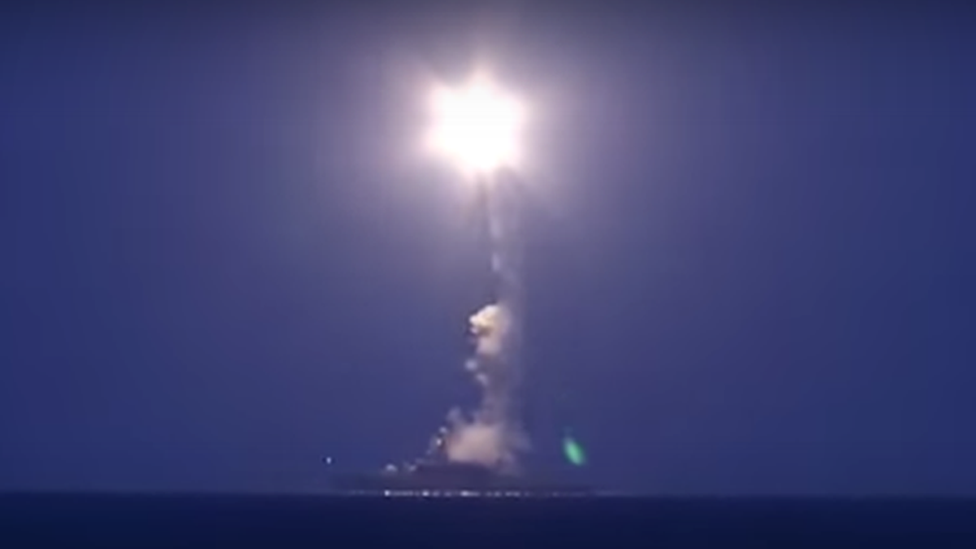
Russia's military said its warships in the Caspian Sea fired 26 missiles
The Caspian Flotilla, together with the Black Sea Fleet, is a maritime part of Russia's Southern Military District, stationed in the port city of Astrakhan. According to the Russian Defence Ministry, external, the flotilla consists of several brigades and divisions of surface ships and coastal troop units, carries out anti-terror activities and protects trade and oil interests.
Syrian boots on the ground
The Russian air force may in some respects be behind its most advanced Western contemporaries, but it certainly has the capacity to mount an effective air campaign. So what then exactly is its mission in Syria?
It is here that there are perhaps the greatest differences between the Russian and US-led air campaigns.
A fundamental weakness afflicting the US and its allies is the absence of credible forces on the ground. Air power can achieve a lot in concert with troops to occupy and hold territory, but in the absence of ground power its impact is limited.
Not so for the Russians. The Syrian government army may not be what it was, having suffered serious losses and defections, but in local terms it is still a force to be reckoned with. Bolstered with new Russian equipment and now backed up by Russian air power, it could hold its own against most of the opposition forces.
Russia does not have the elaborate intelligence-gathering panoply of the US. But much of its targeting will be based upon tactical intelligence obtained from Syrian units on the ground.
This, then, is the key to Russia's strategy. It is to consolidate the Assad regime, to relieve the pressure points and to ensure that its ally remains a factor in any future diplomatic settlement.
To this end - and there are strong indications of this even from Russia's initial air strikes - Moscow will hit any opponents of the Syrian regime where necessary.
Russian air power is not there to roll back the opposition forces and enable the Assad regime to regain control over the large areas of the country that it has lost. It is about buying President Assad time; changing the regional and diplomatic calculations. And to this extent Russian air power could prove a decisive factor.
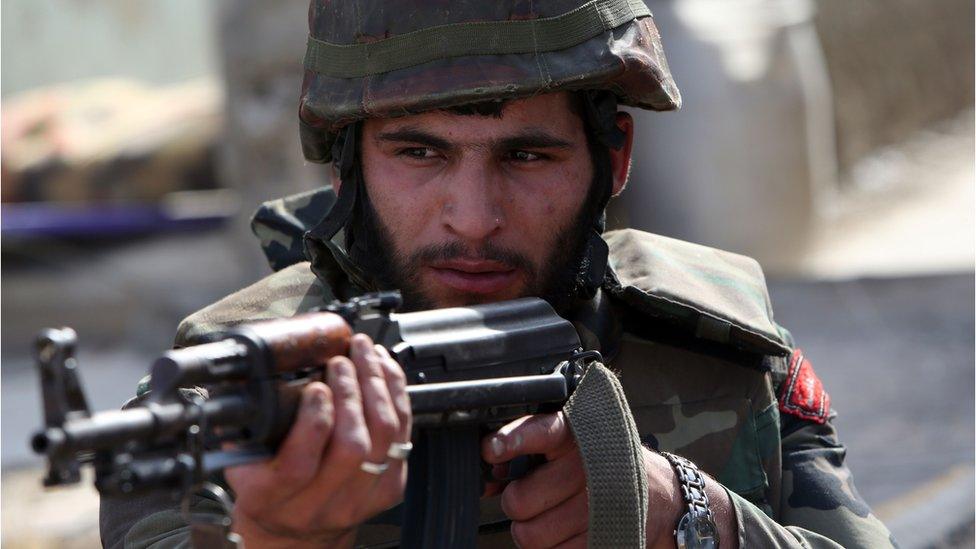
Backed up by Russian air strikes, the Syrian army could hold its own against most of the opposition forces